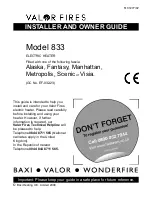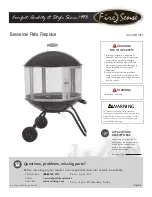
11
G. Take the time and effort to do a professional job. Shortcuts will only
cause you problems and delays in start-up. The majority of failures
in these systems are the result of shortcuts and/or improper joining
techniques.
2. SELECTION OF MATERIALS
PRIMER
It is recommended that Tetrahydrofuran (THF) be used to prepare the
surfaces of pipe and fittings for solvent welding. Do not use water, rags,
gasoline or any other substitutes for cleaning PVC cellular core, ABS or
CPVC surfaces. A chemical cleaner such as MEK may be used.
CEMENT
The cement should be a bodied cement of approximately 500 to 1600
centipoise viscosity containing 10-20% (by weight) virgin PVC material
solvated with tetrahydrofuran (THF). Small quantities of dimethyl formamide
(DMF) may be included to act as a retarding agent to extend curing time.
Select the proper cement; Schedule 40 cement should be used for Schedule
40 pipe. Never use all-purpose cements, commercial glues and adhesives
or ABS cement to join PVC or CPVC pipe and fittings.
SAFETY PRECAUTION: PRIMERS AND CEMENTS ARE EXTREMELY
FLAMMABLE AND MUST NOT BE STORED OR USED NEAR HEAT OR OPEN
FLAME. ALSO, USE IN A WELL-VENTILATED AREA.
CONTROLS AND SWITCHES
The SUF 120 and 240 are provided with four pressure switches. Both the
SUF 150, and 199 are provided with three pressure switches. These
switches are essential to the safe and proper operation of the unit. All
switches are wired in series. The controller is set up to shut the unit down
whenever there is a failure of any of the switches. It is important to
understand the purpose of each switch.
BLOWER PROVER SWITCH
(SEE FIGURE 13)
The Blower Prover Switch is provided on the heater to verify that the fan
is operating. It is a positive pressure switch whose electrical contacts are
normally open. When the fan increases the pressure in the burner, the
pressure switch will allow the electrical contacts to close. The pressure
switch is connected to the burner tap by a piece of tygon tubing. This
tubing must be connected in order for the switch to change the electrical
contacts. The controller requires that the electrical contacts on this air flow
switch be open before it will allow the blower to come on.
BLOCKED OUTLET PROVER SWITCH
(SEE FIGURE 13)
The Blocked Outlet Prover Switch is set up to shut the unit off when a build-
up of positive pressure in the exhaust vent pipe occurs. This switch is a
positive pressure switch that requires an increase in pressure to change
the electrical contacts from normally closed to open. When this switch
prevents the unit from igniting, most likely the exhaust is blocked by some
means Check to see if the condensate is allowed to flow freely from the
exhaust elbow and for obstructions in the exhaust venting and exhaust
vent terminal. Also verify that there is no more than fifty equivalent feet
(15.2 m) of three inch PVC vent pipe on the exhaust.
BLOCKED INLET PROVER SWITCH
(SEE FIGURE 13)
The Blocked Inlet Prover Switch is set up to shut the unit off when a build-
up of negative pressure in the intake vent pipe occurs. This switch is a
negative pressure switch that requires an increase in negative pressure
to change the electrical contacts from normally closed to open. The switch
is connected to the pressure tap on the PVC flange connected to the inlet
of the blower. When this switch prevents the unit from igniting, most likely
the intake is blocked by some means. Check to see if there is no more than
fifty equivalent feet (15.2 m) of three inch PVC vent pipe on the intake. Also
verify that the intake and intake vent terminal is free of obstructions that
may prevent air from entering the unit.
3. 4-inch PVC may be used for a MAXIMUM intake of ONE HUNDRED
TWENTY (120) EQUIVALENT FEET (36.6m) and a MAXIMUM exhaust of
ONE HUNDRED TWENTY (120) EQUIVALENT FEET (36.6m). The
maximum number of 90° elbows with the 4-inch venting is six (6) on the
intake and six (6) on the exhaust. A 90° elbow is equal to five (5)
equivalent feet (1.5m) of pipe. One (1) 90° elbow is equal to two (2)
45° elbows. Any venting configuration using less than 50 equivalent
feet should use 3-inch venting. See Table 2.
The 3-inch venting terminals (provided) must be used with the
4-inch venting by adding 4x3 reducing couplings at the venting terminals.
A reducing coupling is also needed immediately after the condensate
elbow (exhaust) and immediately before the 3-inch blower adapter
(intake) if direct venting is installed. See Table 2.
IMPORTANT
When multiple units are direct vented through a wall (3-inch or 4-inch
venting), all intake vent terminals should be no lower than the highest
exhaust vent terminal.
NOTE: This unit can be vented using only PVC (Class 160, ASTM D-2241
Schedule 40, ASTM D-1785 ; or Cellular Core Schedule 40 DWV, ASTM
F-891) , Schedule 40 CPVC (ASTM F-411), or ABS (ASTM D-2661) pipe.
The fittings, other than the TERMINATIONS should be equivalent to PVC-
DWV fittings meeting ASTM D-2665 (Use CPVC fittings, ASTM F-438 for
CPVC pipe and ABS fittings, ASTM D-2661/3311 for ABS pipe. If CPVC or
ABS pipe and fittings are used, then the proper cement must be used for
all joints, including joining the pipe to the Termination (PVC Material). PVC
Materials should use ASTM D-2564 Grade Cement; CPVC Materials should
use ASTM F-493 Grade Cement and ; ABS Materials should use ASTM
D-2235 Grade Cement.
NOTE: for Water Heaters in locations with high ambient temperatures
(above 100°F or 38°C) and/or insufficient dilution air, it is recommended
that CPVC or ABS pipe and fittings (MUST USE SUPPLIED VENT TERMINAL)
be used.
4. It is important that condensate not be allowed to buildup in the exhaust
vent pipe. To prevent this from happening the pipe should be installed
with a slight, 1/8 inch (3mm) per 5 feet (152 cm) of pipe maximum
downward slope.
5. The vent system should be supported every 5 feet (152 cm) of vertical
run and every 3 feet (91cm) of horizontal run of vent pipe length.
NOTE: Stress levels in the pipe and fittings can be significantly increased
by improper installation. If rigid pipe clamps are used to hold the pipe in
place, or if the pipe cannot move freely through a wall penetration, the pipe
may be directly stressed, or high thermal stresses may be formed when
the pipe heats up and expands. Install accordingly to minimize such stresses.
VENT PIPE PREPARATION
1. INITIAL PREPARATION
A. Make sure the solvent cement you are planning to use is designed
for the specific application you are attempting.
B. Know the physical and chemical characteristics and limitations of
the PVC, PVC cellular core, ABS or CPVC piping materials that you
are about to use.
C. Know the reputation of your pipe and cement manufacturer and
their products.
D. Know your own qualifications or those of your contractor. The
solvent welding technique of joining PVC, PVC cellular core, ABS or
CPVC pipe is a specialized skill just as any other pipe fitting technique.
E. Closely supervise the installation and inspect the finished job before
start-up.
F. Contact the manufacturer, supplier, or competent consulting agency
if you have any questions about the application or installation of
PVC, PVC cellular core, ABS or CPVC pipe.
Summary of Contents for SUF 100 150NE
Page 31: ...31...












































